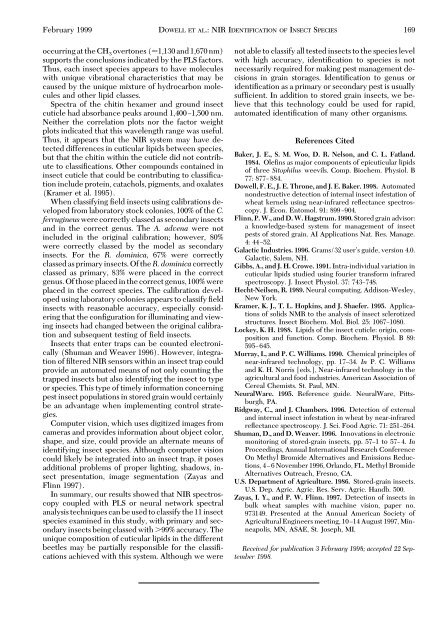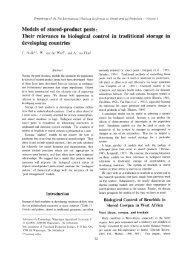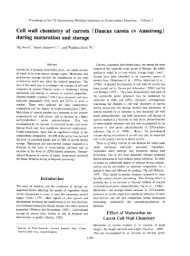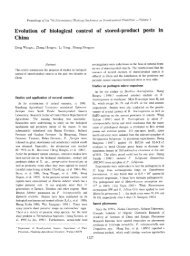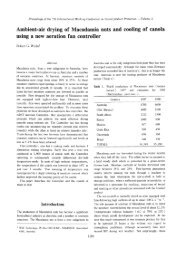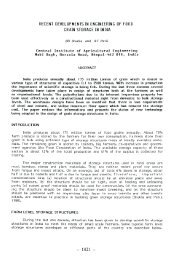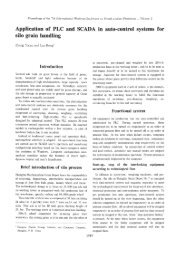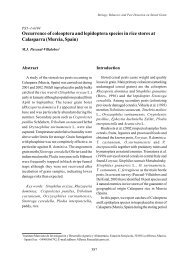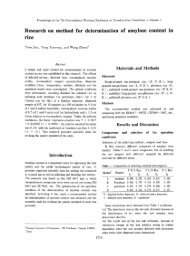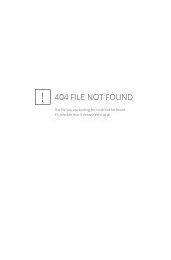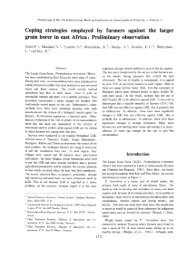Identifying Stored-Grain Insects Using Near-Infrared Spectroscopy
Identifying Stored-Grain Insects Using Near-Infrared Spectroscopy
Identifying Stored-Grain Insects Using Near-Infrared Spectroscopy
You also want an ePaper? Increase the reach of your titles
YUMPU automatically turns print PDFs into web optimized ePapers that Google loves.
February 1999 DOWELL ET AL.: NIR IDENTIFICATION OF INSECT SPECIES 169<br />
occurring at the CH 3 overtones (1,130 and 1,670 nm)<br />
supports the conclusions indicated by the PLS factors.<br />
Thus, each insect species appears to have molecules<br />
with unique vibrational characteristics that may be<br />
caused by the unique mixture of hydrocarbon molecules<br />
and other lipid classes.<br />
Spectra of the chitin hexamer and ground insect<br />
cuticle had absorbance peaks around 1,400Ð1,500 nm.<br />
Neither the correlation plots nor the factor weight<br />
plots indicated that this wavelength range was useful.<br />
Thus, it appears that the NIR system may have detected<br />
differences in cuticular lipids between species,<br />
but that the chitin within the cuticle did not contribute<br />
to classiÞcations. Other compounds contained in<br />
insect cuticle that could be contributing to classiÞcation<br />
include protein, catachols, pigments, and oxalates<br />
(Kramer et al. 1995).<br />
When classifying Þeld insects using calibrations developed<br />
from laboratory stock colonies, 100% of the C.<br />
ferrugineus were correctly classed as secondary insects<br />
and in the correct genus. The A. advena were not<br />
included in the original calibration; however, 80%<br />
were correctly classed by the model as secondary<br />
insects. For the R. dominica, 67% were correctly<br />
classed as primary insects. Of the R. dominica correctly<br />
classed as primary, 83% were placed in the correct<br />
genus. Of those placed in the correct genus, 100% were<br />
placed in the correct species. The calibration developed<br />
using laboratory colonies appears to classify Þeld<br />
insects with reasonable accuracy, especially considering<br />
that the conÞguration for illuminating and viewing<br />
insects had changed between the original calibration<br />
and subsequent testing of Þeld insects.<br />
<strong>Insects</strong> that enter traps can be counted electronically<br />
(Shuman and Weaver 1996). However, integration<br />
of Þltered NIR sensors within an insect trap could<br />
provide an automated means of not only counting the<br />
trapped insects but also identifying the insect to type<br />
or species. This type of timely information concerning<br />
pest insect populations in stored grain would certainly<br />
be an advantage when implementing control strategies.<br />
Computer vision, which uses digitized images from<br />
cameras and provides information about object color,<br />
shape, and size, could provide an alternate means of<br />
identifying insect species. Although computer vision<br />
could likely be integrated into an insect trap, it poses<br />
additional problems of proper lighting, shadows, insect<br />
presentation, image segmentation (Zayas and<br />
Flinn 1997).<br />
In summary, our results showed that NIR spectroscopy<br />
coupled with PLS or neural network spectral<br />
analysis techniques can be used to classify the 11 insect<br />
species examined in this study, with primary and secondary<br />
insects being classed with 99% accuracy. The<br />
unique composition of cuticular lipids in the different<br />
beetles may be partially responsible for the classiÞcations<br />
achieved with this system. Although we were<br />
not able to classify all tested insects to the species level<br />
with high accuracy, identiÞcation to species is not<br />
necessarily required for making pest management decisions<br />
in grain storages. IdentiÞcation to genus or<br />
identiÞcation as a primary or secondary pest is usually<br />
sufÞcient. In addition to stored grain insects, we believe<br />
that this technology could be used for rapid,<br />
automated identiÞcation of many other organisms.<br />
References Cited<br />
Baker, J. E., S. M. Woo, D. R. Nelson, and C. L. Fatland.<br />
1984. OleÞns as major components of epicuticular lipids<br />
of three Sitophilus weevils. Comp. Biochem. Physiol. B<br />
77: 877Ð884.<br />
Dowell, F. E., J. E. Throne, and J. E. Baker. 1998. Automated<br />
nondestructive detection of internal insect infestation of<br />
wheat kernels using near-infrared reßectance spectroscopy.<br />
J. Econ. Entomol. 91: 899Ð904.<br />
Flinn, P. W., and D. W. Hagstrum. 1990. <strong>Stored</strong> grain advisor:<br />
a knowledge-based system for management of insect<br />
pests of stored grain. AI Applications Nat. Res. Manage.<br />
4: 44Ð52.<br />
Galactic Industries. 1996. Grams/32 userÕs guide, version 4.0.<br />
Galactic, Salem, NH.<br />
Gibbs, A., and J. H. Crowe. 1991. Intra-individual variation in<br />
cuticular lipids studied using fourier transform infrared<br />
spectroscopy. J. Insect Physiol. 37: 743Ð748.<br />
Hecht-Neilsen, R. 1989. Neural computing. Addison-Wesley,<br />
New York.<br />
Kramer, K. J., T. L. Hopkins, and J. Shaefer. 1995. Applications<br />
of solids NMR to the analysis of insect sclerotized<br />
structures. Insect Biochem. Mol. Biol. 25: 1067Ð1080.<br />
Lockey, K. H. 1988. Lipids of the insect cuticle: origin, composition<br />
and function. Comp. Biochem. Physiol. B 89:<br />
595Ð645.<br />
Murray, I., and P. C. Williams. 1990. Chemical principles of<br />
near-infrared technology, pp. 17Ð34. In P. C. Williams<br />
and K. H. Norris [eds.], <strong>Near</strong>-infrared technology in the<br />
agricultural and food industries. American Association of<br />
Cereal Chemists. St. Paul, MN.<br />
NeuralWare. 1995. Reference guide. NeuralWare, Pittsburgh,<br />
PA.<br />
Ridgway, C., and J. Chambers. 1996. Detection of external<br />
and internal insect infestation in wheat by near-infrared<br />
reßectance spectroscopy. J. Sci. Food Agric. 71: 251Ð264.<br />
Shuman, D., and D. Weaver. 1996. Innovations in electronic<br />
monitoring of stored-grain insects, pp. 57Ð1 to 57Ð4. In<br />
Proceedings, Annual International Research Conference<br />
On Methyl Bromide Alternatives and Emissions Reductions,<br />
4Ð6 November 1996, Orlando, FL. Methyl Bromide<br />
Alternatives Outreach, Fresno, CA.<br />
U.S. Department of Agriculture. 1986. <strong>Stored</strong>-grain insects.<br />
U.S. Dep. Agric. Agric. Res. Serv. Agric. Handb. 500.<br />
Zayas, I. Y., and P. W. Flinn. 1997. Detection of insects in<br />
bulk wheat samples with machine vision, paper no.<br />
973149. Presented at the Annual American Society of<br />
Agricultural Engineers meeting, 10Ð14 August 1997, Minneapolis,<br />
MN, ASAE, St. Joseph, MI.<br />
Received for publication 3 February 1998; accepted 22 September<br />
1998.


